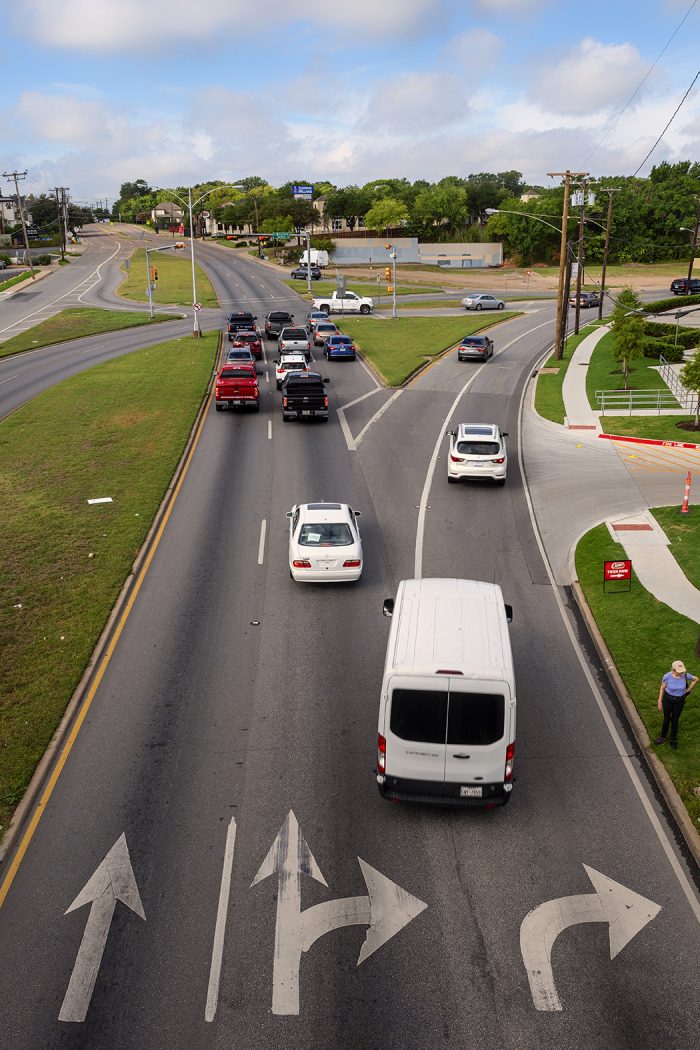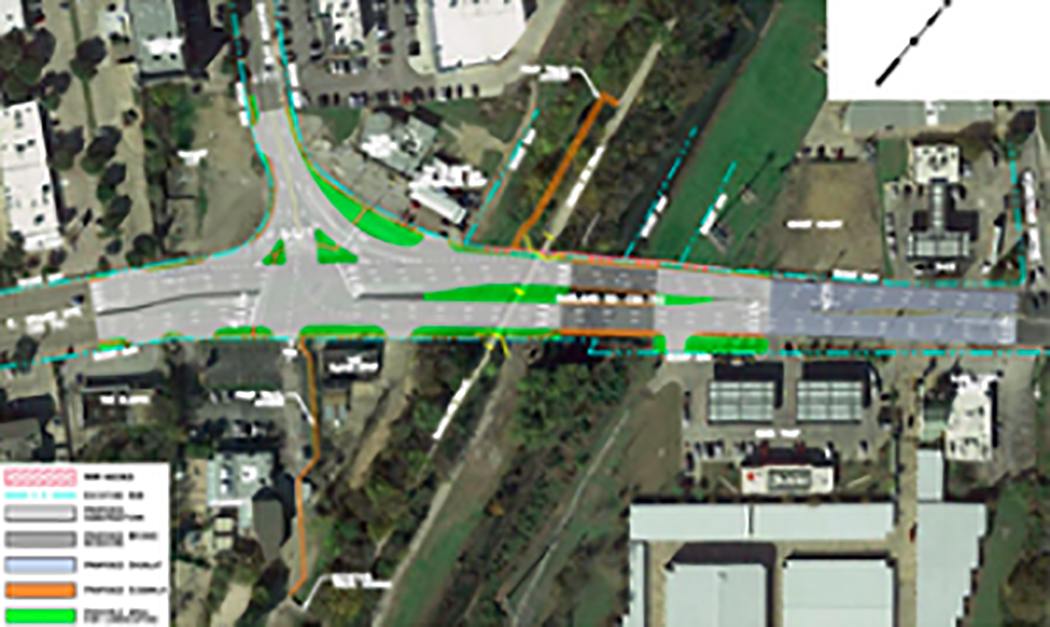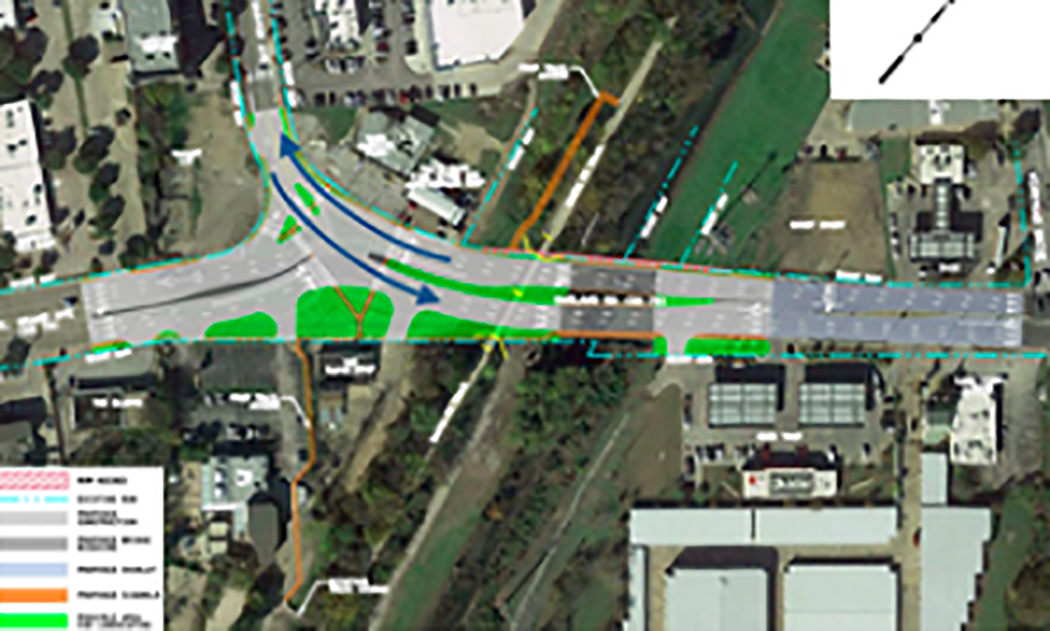
Photo by Danny Fulgencio.
A car heading north on Grand Avenue in East Dallas cruises through the rolling green hills around Tenison Park Golf Course, moves to turn left on Gaston Avenue toward downtown. The driver is met with a convoluted situation.
When the left turn arrow indicates it is time to move, the vehicle proceeds onto westbound Gaston and toward Lakewood. But wait. A yield sign appears. Surely it can’t be for the turning vehicles; there are others behind it in the middle of the intersection. The yield must be for the cars turning right from Garland Road onto Gaston. Right?
Wrong. That yield is for the left-turn vehicles, causing confusion and accidents to reign at Gaston-Garland-Grand.
More than 30,000 vehicles pass through the intersection each day, according to the Texas Department of Transportation (TxDOT), and it desperately needs a redesign. Because Garland and Grand are Texas State Highway 78, the redesign project is a collaboration between the City of Dallas and the Texas Department of Transportation (TxDOT), which is providing most of the funding for the project. The intersection also connects three city council districts, two Texas House districts and two Texas Senate districts, further complicating the matter.
TxDOT began holding meetings about the $5.3 million project in May 2016 and presented six options in a consensus building meeting later in the year. Attendees chose the “Reverse T,” which creates crosswalks, removes the protected right-turn lane from Garland to Gaston and does away with the straight-away lane that transitions from Grand to Garland, curving parts of the intersection to slow down traffic.
The City of Dallas is contributing $1.1 million toward the project as well, and the staff submitted a letter of preference for the Reverse T, or Option 2. But no sooner had the design been chosen than neighbors started offering alternative options and complaining about what the plan would do to traffic in their neighborhoods.

Option 1 (not picked) Traditional T

Option 2 (picked) Reverse T
NEIGHBORS AGAINST OPTION 2
First, representatives of a group called the East Dallas Coalition of Neighborhoods showed up at a public meeting, distributing materials about how much traffic the design would push onto Gaston and through East Dallas. They offered an alternative design that had one right turn lane from Garland to Gaston, hoping to guide traffic toward I-30 rather than through their neighborhood.
Swiss Avenue neighbor Virginia McAlester helped organize the coalition and described their perspective. “Both Garland Road and East Grand are State Highway 78, and both have six lanes, medians and left-turn lanes. East Grand even has wide grassy medians and shoulders for additional safety. Gaston only has four lanes and it is a residential collector to serve local residents and businesses – not highway traffic, even though that is where most of it goes even today.”
Months later, red, white and blue yard signs appeared on Gaston Avenue, asking neighbors to “Say no to Option 2” to keep children and streets safe. A group called the Lakewood Citizens for Responsible Traffic (LCFRT) is behind the effort. They are lobbying for a more traditional T intersection, which they say will maintain current traffic flow toward Gaston Avenue from Garland Road rather than increase it. LCRFT’s website encourages neighbors to write TxDOT and their local and statewide representatives in order to choose another option. A public vote is not part of the process, but the effort drew the attention of TxDOT and local leaders.
“It has been a sham of a public process from the beginning,” Philip Kingston, City Council member of District 14, says of TxDOT’s path toward choosing the design. He and Mark Clayton, City Council member of District 9, say they are working toward finding a compromise.
By the City of Dallas’ own measures, Gaston is already over capacity. According to the city’s Thoroughfare Plan, Gaston Avenue is designated as a “Community Collector,” which is supposed to max out at 14,000 vehicles per day but actually bears the weight of over 20,000 cars each day. Garland/Grand is considered a six-lane principal arterial, which is meant to hold 21,000 vehicles per day. For LCFRT, it doesn’t make sense to continue to overload Gaston with Option 2, whose path makes it easier to turn onto westbound Gaston and requires a left turn to stay on Grand from southbound Gaston.
WHY OTHERS PREFER THE REVERSE T
But representatives of TxDOT says that neither of the options will increase traffic. In an email, TxDOT’s public information officer Michelle Raglon wrote that the traffic assumptions underlying LCFRT’s main argument are incorrect. “Option 2 doesn’t push more traffic onto Gaston, because Gaston is not being widened,” Raglon wrote. “It only helps with reducing intersection delay. Since this project is not adding capacity, a significant change in the traffic pattern is not expected. The traffic analysis performed assumes that both options have the same traffic volumes.”
Other neighbors who have been involved from the beginning think the Option 2, or the Reverse T, is the right choice. John Botefuhr is an East Dallas neighbor, business owner and former president of the Friends of the Santa Fe Trail. He helped jumpstart the intersection redesign several years ago and has been involved in all the public meetings about the area.
As businesses arrive in the area and East Dallas becomes denser, he wants the intersection to be safer and more efficient for everyone, not just for those who live on Gaston. As a result, he favors the original Reverse T plan. He says the shorter crosswalks and reduction of commercial traffic attempting to use Garland-Grand to get to I-30 will have an impact on the safety of the intersection. “They mean well, but they aren’t looking at the entire area,” he says of the opponents to Option 2.
TxDOT representatives believe the Reverse T is the most efficient way to manage traffic at the intersection and say the project has evolved. “The tweaks that have been made have come from several sources.”
Another public hearing is planned sometime this fall. No date had been announced as this magazine went to press. Neighbors and elected officials may comment from a microphone and provide written feedback at that time, potentially leaving open the possibility of changes and continuing to leave the project in a state of limbo.
“Staff will make the best engineering decision on the project with the least amount of impacts on the community,” TxDOT representatives say. “Voting on road projects is not a part of the public involvement process.”





